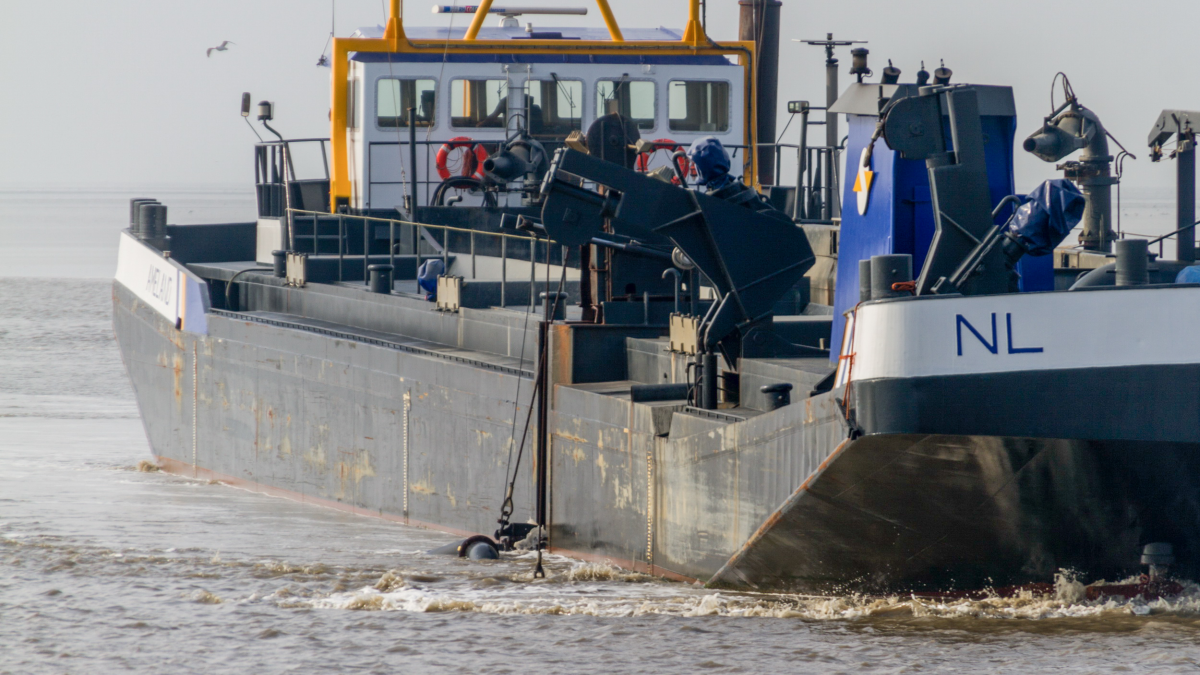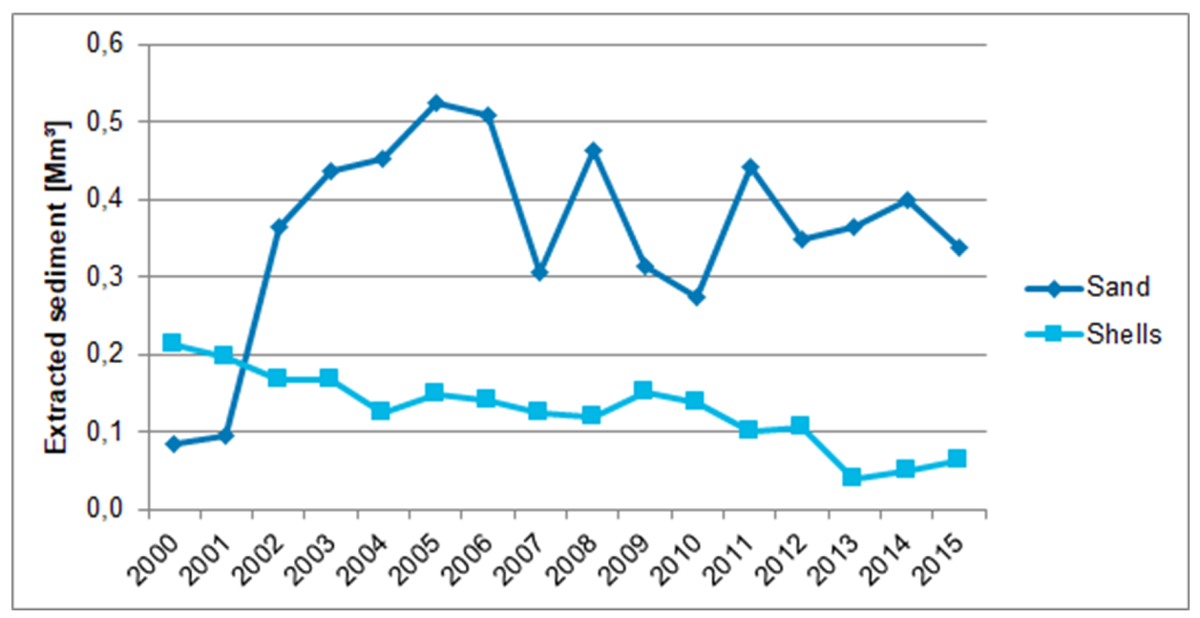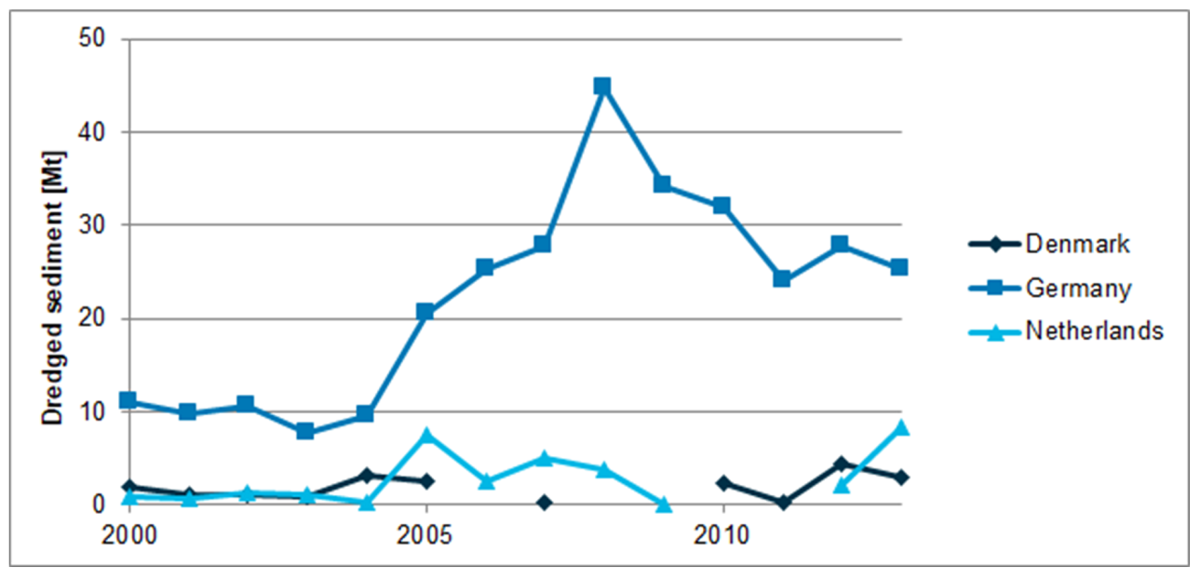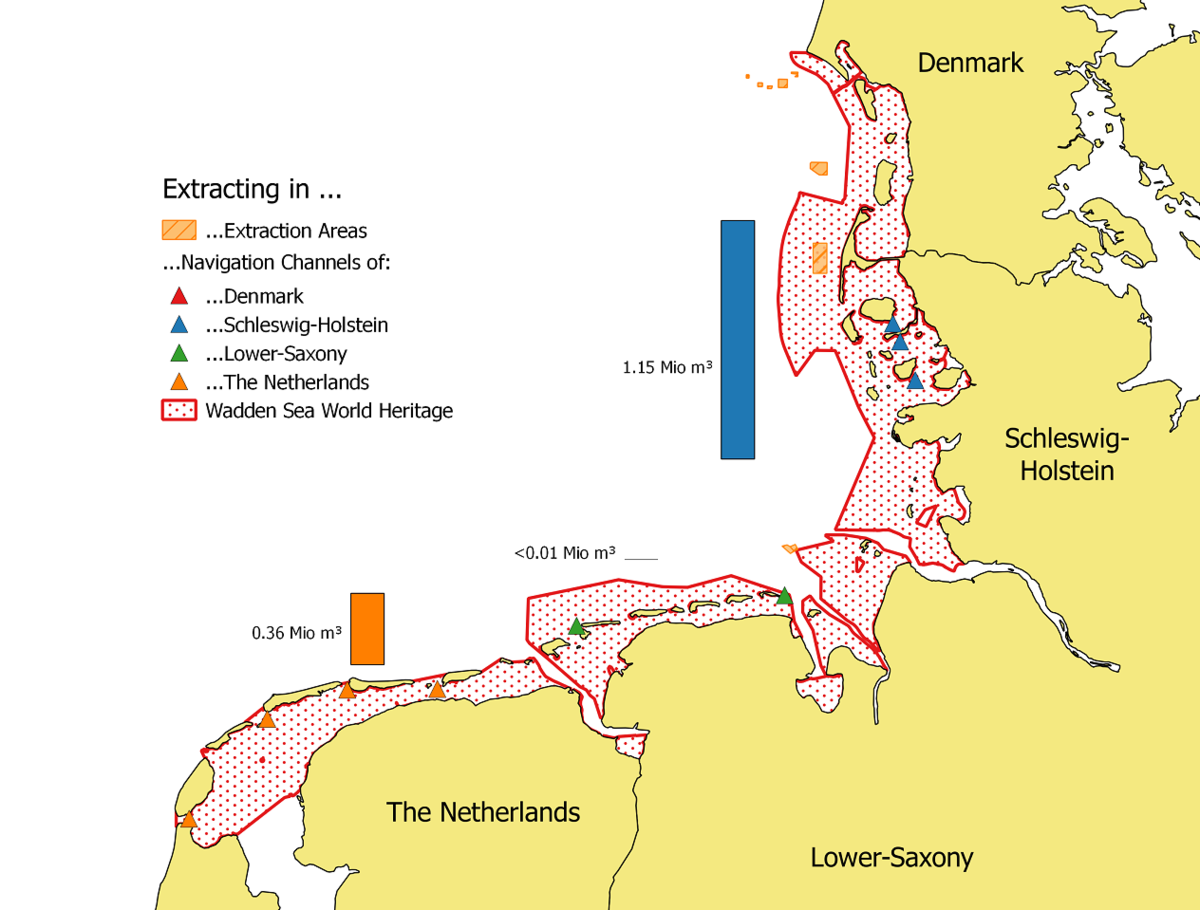
Photo: Rijkswaterstaat/van Reeken (https://beeldbank.rws.nl). Dredging boat.
Extraction and dredging
M. Schultze, G. Nehls
PDF1. Introduction
Dredging and sediment extraction have for long been practiced in the Wadden Sea area. Whereas in former times the material was mainly used for construction of dikes, dwelling mounds and roads, today the main purpose of these activities is the maintenance and deepening of shipping lanes. Over the past decades the effort for sediment extracting steadily decreased within the Wadden Sea. However, still today a certain amount of marine sediment and is used for several purposes in context of coastal protection, such as beach nourishment or dike and dwelling mound reinforcement (on the Halligen).
This report provides a brief overview about the extent and origin of artificial sediment transport within the Wadden Sea area. Furthermore some critical aspects of these measures concerning the environmental integrity of the Wadden Sea ecosystem and its compartments are described.
2. Status and trends
Extraction of sand and shells
The Netherlands
Among all countries around the North Sea, the Netherlands extract the greatest amount of sand from marine sediments. More than 25 million m3 of sand are extracted within Dutch waters every year (ICES, 2013, 2014 & 2016). It is mainly used for coast replenishment or as fill sand on land. To a limited extent sediment extraction also takes place inside the Dutch Wadden Sea Area. Since 2009 every year about 354.000 m³ sand have been extracted from the Dutch Wadden Sea (Figure 1). The greatest amount of sand (290.000 m³ a-1) was regularly extracted in the area between Vlieland and Ameland (Vlie). However, at present sand extraction is only allowed in the Dutch Wadden Sea as a side product of regular maintenance activities with regard to shipping lanes. The commercial sand extraction has been totally transferred to the North Sea beyond the 20 m depth contour (Policy Document on the North Sea 2016-2021). Moreover, it is decided to reduce sand extraction activities in the Dutch Wadden Sea gradually to zero over the coming years as near coast extraction of sand contradicts the current coastal defense policy. With regard to climate change the aim is to preserve existing sediments in the coastal zone for being able to cope with the sea level rise (Rijkswaterstatt, personal communication).
 Figure 1. Amount of extracted sediments within the Dutch Wadden Sea area since 2000 (Sources: ICES, 2016, and Rijkswaterstaat, personal communication).
Figure 1. Amount of extracted sediments within the Dutch Wadden Sea area since 2000 (Sources: ICES, 2016, and Rijkswaterstaat, personal communication).
Beside sand extraction also extraction of shells is still conducted in the Dutch Wadden Sea area. Shell extraction takes place beyond the 5 m depth contour, with an annual removal of up to 0.25 million m3 (ICES-Report). In recent years, shell extraction activities dropped to levels below 0.15 million m3. In 2014 49,161 m³ and in 2015 63,971 m³ of shells were extracted (Figure 1).
Germany
In Germany marine sediments are mainly extracted outside the Wadden Sea. They are used for beach nourishment, construction and coastal protection. In case of commercial extraction, authorization by the State Authority for Mining, Energy and Geology (LBEG) (§ 3 BBergG) is needed.
In recent years, the most significant project has been the JadeWeserPort project, for which in 2009, a total of 19.05 million m3 of sand was extracted. Since 2010 the extracted quantities declined again to a stable level of about 1 million m³ per year (Figures 2 and 3).
Within the German Wadden Sea National Parks, commercial sediment extraction is not allowed. However, in Lower Saxony and Schleswig-Holstein sediment extraction still takes place, usually for coastal defence or related construction purposes (Nationalparkverwaltung Niedersächsisches Wattenmeer and Landesbetrieb für Küstenschutz, Nationalpark und Meeresschutz Schleswig-Holstein, personal communication). In Lower Saxony there are four extraction sites. They all are located near Nordergründe, close to the Weser estuary. In total, these extraction sites, named ‘Delphin’, ‘HBH 1’, ‘Brewaba 1’ and ‘Nordsee 2’, cover an area of about 26.7 km2, with only small overlaps with the National Park. Only the extraction site ‘Brewaba 1’ is still active, but so far no sediment has been extracted there. The maintenance of coastal protection structures and beach nourishment on the islands also demands marine sediments. In recent years small-scale sediment relocations took place on the islands Wangerogge and Juist.
Also within the Wadden Sea of Schleswig-Holstein, between the wadden sea islands and the mainland, extraction of marine sediments still occurs at several sites (Figure 2, blue triangles), solely for the purpose of coastal defence or related measures on the Halligen and Wadden Sea islands. At these sites extraction of quantities less than 15,000 m³ per year is allowed. These activities are authorized directly by Landesbetrieb für Küstenschutz, Nationalpark und Meeresschutz Schleswig-Holstein (LKN-SH) (§ 6 Abs. 3 Nr. 3 Nationalparkgesetz).
Significantly much heavier extraction activities take place in Westerland III. Westerland III is one of the biggest sand extraction sites in the world (about 55 km²). It is located about 5 km to the west of Sylt (Figure 2) and encompasses the former extraction area ‘Westerland II’. Although `Westerland III’ is located outside the actual wadden sea area, it belongs to the Wadden Sea National Park of Schleswig-Holstein and the Wadden Sea World Heritage. It was approved by the State Authority for Mining, Energy and Geology (LBEG) in February 2010 and it is planned to extract about 20–25 million m³ sand from ‘Westerland III’ until 2030. The material is used solely for coastal defence and beach nourishment projects on Sylt (LKN-SH, personal communication).
With regard to climate change and rising sea level, it is expected that also in Germany the demand for sediments for coastal protection projects will increase. One discussed measure for improving the coastal protection at the German coast, is to raise the seabed level of the Wadden Sea. Therefore, it is planned to transport sand from the outer North Sea into the Wadden Sea. Along with this all still existing extracting sites shall be shifted to the North Sea beyond the 15 m depth contour (MELUR-SH, 2016). The extraction of shells is generally prohibited in the German Wadden Sea National Parks.
Denmark
In the past ten years extraction of marine sediments for construction and beach nourishment has been more or less stable in the Danish part of the North Sea with extracted volumes of below 12 million m³ per year (Figure 3). Between 10 % and 15 % of the total marine extraction of sand originates from maintenance and capital dredging. This sand represents an important fraction of the material used for coastal protection, construction and backfill (ICES, 2016).
Within the Danish Wadden Sea, sediment extraction for commercial purposes is not allowed. However, permission for sediment extraction for coastal protection purposes may be granted if suitable material cannot be collected on the landward side of the dike nor in combination with the deepening of shipping lanes. In the past years, this dredged material from inside the Wadden Sea was not suitable for coastal protection purposes. Nevertheless there are extraction activities outside but in close vicinity to the Danish Wadden Sea (Figure 2), which may affect the Wadden Sea ecosystem. In total these sites, all authorized by The Danish Nature Agency (Naturstyrelsen), are covering an area of about 40 km². Since 2007 more than 730.000 m³ sediment (approximately 81.000 m³ per year) have been extracted from these sites for commercial purposes.
Figure 2. Locations and averaged amounts of extracted sediments per year (2006-2013) within the Wadden Sea areas of the Netherlands (orange symbols), Germany (green and blue symbols). Data for Denmark were not available.
 Figure 3: Amount of extracted marine sand within the OSPAR areas of the Netherlands, Germany and Denmark (Source: ICES, 2016).
Figure 3: Amount of extracted marine sand within the OSPAR areas of the Netherlands, Germany and Denmark (Source: ICES, 2016).
Dredging and dumping
Due to the high sedimentation rate dredging and dumping of sediments are essential measures for maintaining harbours and shipping lanes within the Wadden Sea area. According to OSPAR about 90 % of all sediments dumped within the OSPAR region are dredged in the southern North Sea. On average 36 million tons of sediment were dredged in the Wadden Sea area every year between 2006 and 2013, mainly in the estuaries of Elbe, Weser, Jade and Ems. In 2008 even 48.5 million tons of sand were relocated by dredging and dumping to other places within the Wadden Sea (OSPAR, 2010).
Among the three participating countries, the largest quantity of dredged material accumulates in Germany (Figure 4). This is mainly due to dredging and dumping activities within estuaries of Elbe, Weser, Jade and Ems to mitigate the high sedimentation rate. Since 2005 at least20 million tons of sediment were dredged every year in these regions. In 2008 an amount of even approximately 45 million tons of clay, sand and mud were dredged. Although the deepening of the Elbe to 17 m, original scheduled for the years 2007-2010, was not implemented so far, the greater part of the dredged material originates from the Elbe in these years.
In Germany permits for dredging or dumping activities are issued by the responsible authority of the particular Federal State. The responsible authorities for dredging activities are the German Federal Water and Shipping Directorates. Since these institutions are both, approving and executing agencies, they do not issue permits for their own activities. However, the dredging and dumping activities of the directorates are governed by national regulations which are in accordance with OSPAR requirements.
In the Dutch part of the Wadden Sea there are no prominent estuaries with major shipping lanes, thus the annual quantities of dredged and dumped material are markedly lower than in Germany (Figure 4). The annual quantities since 2005 vary between 1 and 10 million tons. Also in Denmark prominent estuaries with shipping lanes are lacking, hence the dredged quantities of sediment are lower than in Germany (Figure 4). In recent years they vary between 1 and 5 million tons per year.
 Figure 4. Amounts of dredged sediments within the Wadden Sea areas of the Netherlands, Germany and Denmark (Source: OSPAR Reports).
Figure 4. Amounts of dredged sediments within the Wadden Sea areas of the Netherlands, Germany and Denmark (Source: OSPAR Reports).
Figure 5. Locations and averaged amounts of dredged sediments per year (2006-2013) within the Wadden Sea areas of the Netherlands, (orange symbols), Germany (green and blue symbols),Denmark (red symbols) and the shipping lanes within the rivers Ems, Jade, Weser and Elbe (Source: OSPAR Reports).
Environmental impacts of dredging and extracting
Extracting, dredging and dumping of marine sediments might all affect the integrity of the marine environment and should thus be avoided or the amount of dredged material and the area of extraction sites should be minimized. First of all the activities have impact to the seabed by impairing benthic habitats and benthic communities. Dredging and in particular extracting of sand, clay, mud or gravel, all directly remove benthic fauna and flora associated with the sediment and hence often result in serious local decrease of population sizes, species diversity and community biomass. Due to the trophic interactions, adverse effects also have to be expected on fish larvae, and therefore on the food availability for fish, birds and marine mammals. The recovery rate after such impacts varies from a few years to decades (ICES, 2016). Keeping parts of the original seabed untouched is crucial for later repopulation and the recovery of benthic communities of the affected areas. According to present knowledge, extraction to greater depths is more efficient, both in terms of costs and space, and with regard to minimize impacts to the environment. Therefore, the extraction of a certain amount of sediment to greater depths within a smaller surface area should be prioritised over shallower extraction affecting a larger surface area.
Other impairments occur in the vicinity of dumping sites of dredged material. In particular sediments from harbours and estuaries are often contaminated with heavy metals (originating from chemical and metal industry), tributyl tin hydride (TBT, from anti-fouling paints), possibly microplastics and other harmful pollutants. The suspension of sediments in the water column by dredging, dumping and extracting, may result in greater proportions of these substances being dissolved in the water column and thus being accumulated to a higher extent in the food chain. Also reducing substances (e.g. organic matter, sulphides, ammonium), originally bound in the sediment and chelated to fine particles may be released into the water column. Particularly in estuaries, where the content of these compounds in the sediment usually are high, the oxygen level in the water may be locally lowered to concentrations that are critical to fish and other marine organisms.
Today, impacts of dumped sediments on the marine environment seem to be lower than in the 1980s. The OSPAR Commission states on their website, that the release of contaminants (heavy metals and TBT) to the water column presents the main risk by dredged and dumped sediments. But in particular an improved dredging management conducted by the national authorities, following the OSPAR guidelines (recent version adopted in 2014), helped to reduce the pollution at dumpsites in the southern North Sea. In the Netherlands, TBT concentrations in dredged material have fallen since the monitoring started in 1998. Certainly the global ban of TBT-based antifoulants, established in September 2008, will cause a further but slow decline of TBT concentration in sediments.
Vessels used for dredging and dumping activities emit underwater noise. This extra noise to the environment is usually not caused by the dredging or extracting activity itself, but by the operating vessels. So far, there are no relevant effects to the marine environment described from this pressure. However, there is indication that noise from ships causes disturbance to fish and marine mammals and it cannot be excluded that such disturbances may induce physiological and behavioural changes to impaired animals (ICES, 2016) Also the visual disturbance by dredging vessels may have an impact on sensitive species. Particularly sensitive species, such as common scoter, red-throated diver, harbour porpoise and seals are regarded to be impaired by such activities (ICES, 2016).
For the future an increase of dredging and extracting activities is expected. On the one hand ships become bigger. Hence, if harbors at upper estuary cities are maintained, the need for deeper and wider navigation channels will increase. On the other hand along with climate change more and stronger storms are expected, resulting in an increased demand of sediment material for coastal protection. Harmful effects of an increasing need for dredging and dumping may partly be compensated by an improved dredging management and more effort in selecting appropriate dumping locations. However, for mitigating effects of the climate change (raising sea level, stronger, and more frequent storms) sediment must remain within the Wadden Sea system. Therefore future measures for coastal protection must also include a comprehensive conservation of the Wadden Sea sediment, but extracting activities within the Wadden Sea must be ceased.
3. Assessment
Dredging and extracting events both cause environmental impacts. In particular contamination of dredged material has to be considered as a serious issue and hence, the release of pollutants into the Wadden Sea ecosystem has to be avoided. Therefore the Wadden Sea Plan postulates that the participating countries shall develop and apply national threshold values for contaminants in disposed material. All participating countries of the World Heritage developed such values (OSPAR Reports). In Germany a system with two levels, one lower and one upper level, was established for the most common pollutants. Also the Netherlands and Denmark have national threshold values for the most harmful contaminants in dredged material. In Denmark a 3-category system with two levels of action values is established by the Agency for Spatial and Environmental Planning. In general lower action levels correspond to background levels or harmless levels of contamination. The upper action levels are based on international recognised levels, which are suspected to be ecotoxicologically relevant.
In case of sediment extraction, the main purpose of the Wadden Sea Plan is to keep as much sediment as possible within the Wadden Sea. This becomes particularly important in context of climate change and accelerated rates of sea level-rise. Thus, the Wadden Sea Plan concludes that commercial sediment extraction within the Wadden Sea must be avoided. Also the use of Wadden Sea sediment for coastal protection purposes should bekept to a minimum. Only in special cases, if there is urgent and sudden need, its use for coastal defence purposes is acceptable. In general, sediment extraction within the Wadden Sea Area shall be limited to dredging and maintenance activities for shipping lanes. All activities should be carried out in such a way that the impacts to the environment are minimized. Permanent or long-term effects have to be avoided or compensated.
As these targets are commonly accepted by the participating countries, the Netherlands shifted the commercial sand extraction completely to the North Sea beyond the 20 m depth contour. Today extraction of sand within the Dutch Wadden Sea is only allowed as a side product of regular maintenance activities with regard to shipping lanes. Also in Germany only few extraction activities are still conducted within the Wadden Sea. Similar as in the Netherlands it is discussed to shift all extraction activities beyond the 15 m depth contour (MELUR-SH, 2016).
4. Summary
Dredging and marine sediment extraction both have been carried out during decades or even centuries in the Wadden Sea area. Due to high sedimentation rates in the Wadden Sea particularly dredging is an essential measure for maintaining harbours and shipping lanes. Between 2006 and 2013 an annual average of 36 million tons of sand was dredged within the Wadden Sea. Since the highest sedimentation rates occur within the estuaries of Elbe, Weser, Jade and Ems, the largest quantities were dredged within these regions. In the past decade particularly the maintenance of the navigation channel of the Elbe (2005-2010) required a high effort of dredging activities.
Whereas in former times extracted marine sediments were mainly used for onshore construction and similar commercial purposes, today its use is generally restricted to coastal protection activities. However, also today large quantities of sediment are still extracted from the Wadden Sea every year. One of the biggest extraction sites, called Westerland III, is located 5 km west of Sylt. The extracted sand is used for beach nourishment and the coastal protection of Sylt. Approximately 1.1 million tons of sand are removed from this extracting site every year.
Since dredging and extracting both are connected with harmful effects to the marine environment, several strategies were developed to minimize environmental impacts. Especially strategies for reducing harmful effects of contaminants from dredged material were successfully developed and established.
Although there is still a high demand for marine sand as raw material for construction purposes, the participating countries increasingly decide to shift all sediment extraction activities to areas outside the Wadden Sea in the open North Sea beyond certain depth contours. To compensate the rising sea level there is even intension to rise the seabed level of the Wadden Sea by introducing sediments to the Wadden Sea originating from the open North Sea.
About the authorsM. Schultze, Georg Nehls BioConsult SH, Schobüller Str. 36, 25813 Husum, Germany |
AcknowledgementWe would like to warmly thank the following persons for providing information and advices: |
References
MELUR-SH (2016) Strategie für das Wattenmeer 2100. Strategiebericht 2016. Kiel.
Common Wadden Sea Secretariat (CWSS) (2010) Wadden Sea Plan 2010. Eleventh Trilateral Governmental Conference on the Protection of the Wadden Sea. Wilhelmshaven.
ICES (2002) The Working Group on the Effects of Extraction of Marine Sediments on the Marine Ecosystem (WGEXT). ICES CM 2003/ E:07.
ICES (2013) Report of the Working Group on the Effects of Extraction of Marine Sediments on the Marine Ecosystem (WGEXT). ICES CM 2013/SSGHIE:14.
ICES (2014) First Interim Report of the Working Group on the Effects of Extraction of Marine Sediments on the Marine Ecosystem (WGEXT). ICES CM 2014/SSGHIE:07.
ICES (2016) Effects of extraction of marine sediments on the marine environment 2005 – 2011. ICES Cooperative Research Report No: 330/2016.
KUEFOG (2011) Integrierter Bewirtschaftungsplan Weser, Fachbeitrag 1: Natura 2000.
OSPAR Commission (2009) Dumping of Wastes at Sea in 2007 Publ.-No: 432/2009.
OSPAR Commission (2010) Dumping of Wastes at Sea in 2008 Publ.-No: 518/2010.
OSPAR Commission (2011) Dumping of Wastes at Sea in 2009 Publ.-No: 545/2011.
OSPAR Commission (2012) Dumping of Wastes at Sea in 2010 Publ.-No: 572/2012.
OSPAR Commission (2013) Dumping of Wastes at Sea in 2011 Publ.-No: 607/2013.
OSPAR Commission (2014) Dumping of Wastes at Sea in 2012 Publ.-No: 625/2014.
OSPAR Commission (2015) Dumping of Wastes at Sea in 2013 Publ.-No: 650/2015.
The Dutch Ministry of Infrastructure and the Environment & The Dutch Ministry of Economic Affairs (2015) Policy Document on the North Sea 2016-2021.
This report should be cited as: Schultze M. & Nehls G. (2017) Extraction and dredging. In: Wadden Sea Quality Status Report 2017. Eds.: Kloepper S. et al., Common Wadden Sea Secretariat, Wilhelmshaven, Germany. Last updated 21.12.2017. Downloaded DD.MM.YYYY. qsr.waddensea-worldheritage.org/reports/extraction-and-dredging


